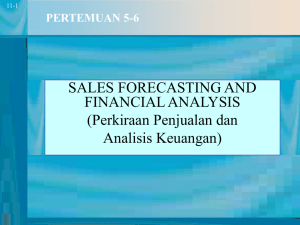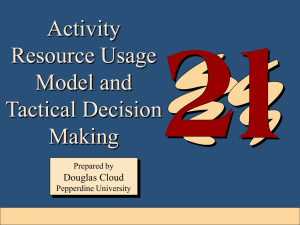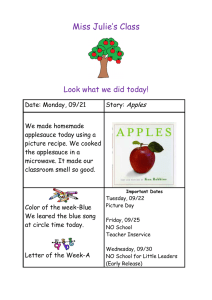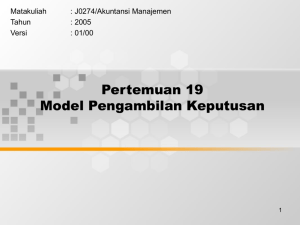Pertemuan 08 Tactical Decision Making Process Matakuliah : J0274/Akuntansi Manajemen
advertisement
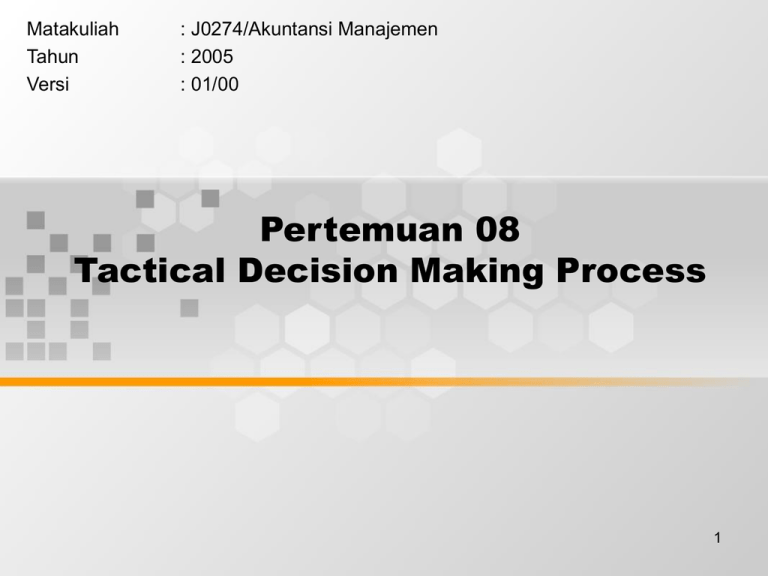
Matakuliah Tahun Versi : J0274/Akuntansi Manajemen : 2005 : 01/00 Pertemuan 08 Tactical Decision Making Process 1 Learning Outcomes Pada akhir pertemuan ini, diharapkan mahasiswa akan mampu : • Memahami pentingnya pengambilan keputusan secara taktis D2182-Armanto W 2 Outline Materi • Implikasi financial atas suatu pengambilan keputusan • Tactical Decision Making Process • Contoh D2182-Armanto W 3 Profesional Intelect 1. Care-why. Represents self-motivated creativity that exists in a company. 2. Know-why. A system’s understanding represents the know-why aspect of knowledge. 3. Know-how. Represents the ability to translate bookish knowledge into real-world results. 4. Know-what. Represents cognitive knowledge. D2182-Armanto W 4 Evaluasi atas Implikasi Finansial • Para Manajer harus mengevalauasi implikasi finansial atas keputusan yang memerlukan trade-offs antara biaya dengan manfaat atas alternatif yang berbeda • Contoh implikasi finansial yang penting untuk dipertimbangkan : – Desain ulang seluruh proses produksi • Informasi finansial berkenaan dengan berbagai tipe biaya menjadi dasar keputusan atas aktivitas organisasi dan proses D2182-Armanto W 5 Relevant Cost dan Pendapatan • Apakah Biaya dan pendapatan adalah relevant bagi pengambilan keputusan sangat terbantung pada konteks keputusan dan alternatif yang tersedia • Dalam pemilihan alternatif konsentrasi hendaknya pada biaya dan pendapatan yang berbeda di setiap alternatif – Harus merupakan biaya dan pendapatan yang relevant – Opportunity costs sesuai definisinya merupakan relevant cost – Biaya yang tidak berubah apapun keputusan yang diambil tidak relevant bagi pengambilan keputusan D2182-Armanto W 6 D2182-Armanto W The Tactical DecisionMaking Process Tactical decision making terdiri atas pemilihan alternatif dengan suatu pandangan terbatas . 7 The Tactical DecisionMaking Process 1. Kenali dan definisikan masalah . 2. Identifikasi alternatif sebagai solusi yang memungkinkan atas masalah, dan eliminasi alternatif yang tidak feasible. 3. Identify the predicted costs and benefits associated with each feasible alternative. Eliminate the costs and benefits that are not relevant to the decision. D2182-Armanto W Continued 8 D2182-Armanto W The Tactical DecisionMaking Process 4. Compare the relevant costs and benefits for each alternative, and then relate each alternative to the overall strategic goals of the firm and other important qualitative factors. 5. Select the alternative with the greatest benefit which also supports the organization’s strategic objectives. 9 The Tactical DecisionMaking Process—Example Step 1: Define the Problem Each year 25 percent of the harvest by an apple processor is small and odd-shaped. These apples cannot be sold in the normal distribution channels and have simply been dumped in the orchards for fertilizer. What should the firm do with these apples? D2182-Armanto W 10 D2182-Armanto W The Tactical DecisionMaking Process—Example Step 2: Identify Feasible Alternatives 1. Sell the applies to pig farmers. 2. Bag the applies in five-pound bags and sell them to local supermarkets as seconds. 3. Rent a local canning facility and convert the apples to applesauce. 4. Rent a local canning facility and convert the applies to pie filling. 5. Continue with the current dumping practice. 11 D2182-Armanto W The Tactical DecisionMaking Process—Example Step 3: Predicting Costs and Benefits and Eliminating Irrelevant Costs Labor and materials (bags and ties) for the bagging option would cost $0.05 per pound. A five-pound bag of apple could be sold for $1.30 to local supermarkets. Making applesauce would cost $0.40 per pound for rent, labor, apples, cans, and other materials. It takes six pounds of apples to produce five, 16-ounce cans of applesauce. Each can sells for $0.78. 12 D2182-Armanto W The Tactical DecisionMaking Process—Example Step 4: Comparing Relevant Costs and Relating to Strategic Goals. The bagging alternative costs $0.25 to produce a five-pound bag ($0.05 x 5 pounds). The revenue is $1.30 per bag, or $0.26 per pound. The net benefit is $0.21 per pound ($0.26 – $0.05). The net benefit of converting the apples into applesauce is $0.25 per pound ($0.65 – $0.40). 13 D2182-Armanto W The Tactical DecisionMaking Process—Example Step 5: Select Best Alternative. Since the apple producer is reluctant to follow a forward integration strategy, the bagging alternative should be chosen. 14 The Tactical DecisionMaking Process—Review Step 1 Step 2 D2182-Armanto W Continued Define Problem Identify Alternatives What to do with small, ill-shaped apples. 1. Sell to pig farmers. 2. Sell bagged apples (feasible). 3. Make applesauce (feasible). 4. Make pie filling. 5. Continue dumping. 15 Step 3 Step 4 Continued D2182-Armanto W Predict Costs Compare Costs Bagged alternative: a. Revenue $1.30 per bag ($0.26 per pound) b. Cost $0.05 per pound Applesauce alternative: a. Revenue: $0.78 per can ($0.65 per pound) b. Cost: $0.40 per pound Bagged Applesauce Revenue $0.26 Cost 0.05 Net benefit $0.21 $0.65 0.40 $0.25 Bagged: Differentiation Applesauce: Forward integration 16 Step 5 D2182-Armanto W Select Alternatives Select bagging alternative because it is profitable and is more consistent with strategic positioning desired by producer. 17 D2182-Armanto W Relevant Costs Defined Relevant costs are future costs that differ across alternatives. A cost must not only be a future cost but must also differ between alternatives. 18 Irrelevant Cost Illustrated Sunk costs are past costs. D2182-Armanto W Example: The original cost of a building is a sunk cost when you are trying to decide whether or not to sell the business five years later. 19 D2182-Armanto W Flexible Resources Flexible resources can be easily purchased in the amount needed and at the time of use… like electricity. 20 D2182-Armanto W Flexible Resources Flexible Resources a. Demand Changes Relevant b. Demand Constant Not Relevant 21 D2182-Armanto W Committed Resources Committed resources are purchased before they are used, such as salaried employees. 22 Committed Resources Committed Resources Supply – Demand = Unused Capacity a. Demand Increase < Unused Capacity Not relevant b. Demand Increase > Unused Capacity Relevant c. Demand Decease (Permanent) 1. Activity Capacity Reduced Relevant 2. Activity Capacity Unchanged Not Relevant D2182-Armanto W 23 Committed Resources—Example A company has five manufacturing engineers who supply a capacity of 10,000 engineering hours (2,000 hours each). The cost of this activity capacity is $250,000, or $25 per hour. The firm expects to use 9,000 hours. If the firm decides to reject a special order requiring 500 hours, the cost of engineering would be irrelevant. D2182-Armanto W 24 D2182-Armanto W Committed Resources—Example The firm can purchase a component that will drop the demand from engineering hours from 9,000 to 7,000. Since engineering activity capacity is acquired in chunks of 2,000, the company can lay off one engineer or reassign the engineer to another plant. 25
